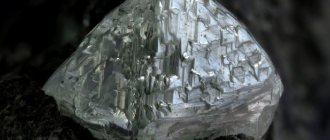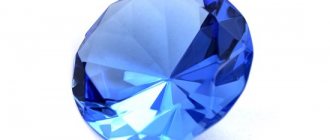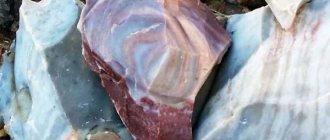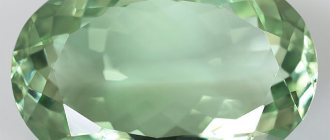The mineral sphalerite is a zinc sulfide, and a major source of zinc metal mining due to its high abundance. It is often called “zinc blende”, since the stone contains an accompanying admixture of iron, which, with different contents, significantly affects its appearance. For this reason, sphalerites are often confused with other minerals, such as galenas. And because of the wide range of colors characteristic of the stone, it also received many names, including pseudogalenas, “honey blende”, “ruby blende”, marmarites, cleiophanes and others. All these minerals are essentially subspecies with different colors and accompanying metals in their composition.
Sphalerite deposits
Sphalerite is a common stone.
It can form in a wide variety of geological conditions, and can be found in sedimentary deposits, low- and high-temperature hydrothermal deposits, and even in limestone. There are associations of sphalerite with vein masses of barites, quartzes and fluorites, with galenas, pyrites and marcasites. — Advertising —
Beautiful examples that can be cut have been discovered in deposits in Spain and Mexico. These sphalerites can range from small crystals to up to 70 carats in weight. Sphalerite crystals of small sizes (up to 10 carats) are mined in the USA, Italy, Czech Republic, and Russia.
In addition to individual crystals, sphalerite intergrowths with quartz, galena and chalcopyrite are very popular.
History of sphalerite
The mineral's name refers to its "deceptive appearance", in ancient Greek the term "sphaleros" means "treacherous" or "deceptive". This is due to the fact that it is often found in polymetallic ores together with galenas and is confused with the latter. The lead-zinc rock contains more sphalerite, and in the copper- and sulfur-pyrite rock, galena replaces it, but it is very difficult to distinguish between the stones, which is a problem for copper smelters.
The first explorers
The deceptive mineral was first explored and described in the book “De natura fossilum” by the famous German metallurgist and ore explorer Georg Agricola (1546). Then, during the Renaissance, there were no scientific classifications or generally accepted names (except magical ones) for many minerals and semi-precious stones. In his work, Agricola calls the stone according to the tradition of German miners: B lende - blende .
The modern name - Sphalerite - was introduced by the German scientist Ernst Glocker in the mid-19th century. In Greek this word means treacherous, treacherous, deceptive.
Physico-chemical characteristics of sphalerite
The composition of sphalerite includes compounds of zinc, sulfur, iron, cadmium, and indium.
Its crystals have a simple shape, or they are polysynthetic and spinel twins, dense cryptocrystalline or fine, medium or coarse-grained aggregates, shelllike intergrowths, spherulites, kidney-shaped colloform spherulite crusts. The structure of the mineral is very similar to diamond. Crystals have a tetrahedral or rhombic-dodecahedral or cubic system. — Advertising —
Color palette: from colorless and light yellow to red, gray and dark gray samples, with a diamond shine, transparent or translucent, fragile.
Hardness on the Mohs scale 3.5-4, specific gravity 2.36-2.37 g/cm3. The crystals have perfect cleavage and uneven fracture.
Sphalerite is decomposed by nitrate and hydrochloric acid. Some varieties exhibit fluorescence or triboluminescence.
Associated minerals are galenas, dolomites, quartz, barites, and similar minerals are galenas, wolframites, cassiterites.
Stone care
Sphalerite is a fragile stone, unstable to temperature, acids and other chemical elements. Therefore, caring for it requires compliance with some rules:
- Products with it should not be dropped or hit, and should not be allowed to come into contact with more durable stones.
- It is better to store in individual cells, and not in a common box; it is better to lay soft material (for example, velvet) along the walls;
- You should not wear jewelry with a gem when cleaning, cooking, working in the garden, or working out in the gym.
- It is better to clean products in warm soapy water.
Following these rules will preserve the beauty and properties of the mineral for a long time.
Types of sphalerite
— Advertising —
Sphalerite may contain impurities of various metals, which is why it is characterized by a wide range of colors and varied appearance, according to which the following types of stone are distinguished:
- Marmarites are opaque, black minerals with a high iron content;
- Marmasolites are partially destroyed marmarites with a low percentage of iron and high fragility;
- Przybramites are yellowish translucent specimens with a high percentage of cadmium;
- Cleiophanes are transparent crystals, colored honey, light yellow or greenish, and do not contain iron;
- Brunkites - can be whitish or light yellow, and are part of the alumina rock.
How to distinguish from a fake?
The cost of ornamental sphalerite is low, so it is of little interest to craftsmen who make fake stones. When purchasing it, you should still ask the seller for a mineral quality certificate and pay attention to the cost.
Jewelry-quality samples of sphalerite, although they have a high price, are very rare. Jewelry with them cannot be found at stone fairs; they are usually sold in single copies and in trusted salons. A distinctive feature of sphalerite from synthetic analogues in such cases is its high fragility - even a slight mechanical impact leaves a mark on the surface of the stone.
Magical properties of sphalerite
In rituals of dark magic, black sphalerite was used to communicate with the world of spirits.
But the stone has never been used to harm other people, since it returns the negative energy that they tried to direct through it to someone, and even on a larger scale. White stones are considered strong amulets, protectors from envy, malice, damage and the evil eye.
Sphalerites, colored yellow, will help a person find peace, hope and optimism.
The magic of the Black Nest
The black crystal of sphalerite is capable of deceiving not only simple-minded miners, it dangerously misleads even experienced magicians.
In magical practices, black crystals are used for mental penetration into the afterlife, casting spells on people and pets. Such accessories include morion, obsidian, jet, black tourmaline, opal, carbonado diamond, black amber (stanthienite), etc. But if a sorcerer performs a spell ritual with a crystal of black zinc blende (the modern name is marmatite), then the curse can turn against itself. caster. The sorcerer is not able to remove it on his own; this can only be done by another magician. In this case, the unlucky spellcaster falls into slavery to the wizard who rescued him.
In magical treatises, the Druze call such treacherous sphalerite-marmatite crystals the “Black Nest.”
Medicinal properties of sphalerite
Since sphalerite contains a lot of zinc, it was previously used in the creation of means for purifying the blood and normalizing the functioning of the gastrointestinal tract.
In general, sphalerites have a positive effect on the human body, increase vitality and improve immunity. Traditional medicine recommends black sphalerite in the treatment of colds and the effects of hypothermia. Yellow samples are used in vision restoration. White sphalerites have a good effect on a person’s psycho-emotional state, relieve tension and irritation, normalize sleep and help to find peace of mind.
Applications for sphalerite
Sphalerite is the main raw material in zinc smelting, while cadmium, gallium and indium are additionally mined.
All of these metals are rare and expensive, but they are necessary for innovative developments in electronic systems. The steel is coated with zinc to prevent corrosion. Zinc is also alloyed with copper to produce a very valuable industrial alloy, brass. The paint and varnish industry uses zinc for the production of zinc white, luminous enamel and compositions necessary for instrument making.
Zinc is also an effective and efficient anti-inflammatory and antiseptic agent used in the pharmaceutical and drug manufacturing industries.
Sphalerites, which formed intergrowths with magnetites, quartz, chalcopyrites and galenas, are used as ornamental material. They are used to make decorative items and souvenirs. The so-called “chipmunk ore”, striped, unusual and beautiful, is especially popular for these purposes.
In jewelry, sphalerite is used to a limited extent because it is soft and brittle. After cabochon cutting, the inserts are used in rings, pendants, pendants, earrings, men's rings and bracelets. But, unfortunately, sphalerite does not retain its original appearance in such jewelry for long.
Mineral samples unique in shape and color are in demand among collectors.
Interesting facts about sphalerite
- Talismans and amulets with sphalerite are recommended for people who lack self-confidence in order to develop leadership qualities, fortitude, and achieve success. An untreated stone of any shade except black is suitable for this. An amulet made of transparent yellow stone will protect the owner from slander, envy, the evil eye, reduce irritability, anger and rage, and become a source of harmony and peace. In addition, such a talisman will prevent nightmares and insomnia.
- The effect of high temperatures on sphalerite depends on how much iron the sample contains. If there is a lot of iron, the stone will melt very easily, but pure mineral is resistant even to the effects of a blowpipe. The purity of sphalerite is also indicated by the color of the residue in the reduction flame: if the sample contains cadmium, then a brown-red coating is visible on it, while on a pure sample it is white.
Zodiac compatibility
Astrologers believe that sphalerite is influenced by two planets - Mars and Venus, so wearing a piece with a crystal will help the owner find harmony and courage. Despite the fact that the stone has been known to people for a long time, for astrology the insidious mineral remains a mystery, therefore the advice of astrologers is contradictory and changeable.
Sphalerite is cool towards Scorpios.
Representatives of the sign who wear a deceptive stone often find themselves in bad situations, so Scorpios should refrain from purchasing a crystal.
The stone is favorable to Taurus. The mineral bestows strength, good luck and helps in every possible way to representatives of this sign, protecting them from misfortunes, gossip and hasty decisions.











